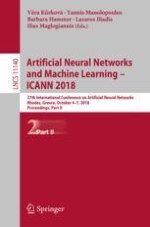This three-volume set LNCS 11139-11141 constitutes the refereed proceedings of the 27th International Conference on Artificial Neural Networks, ICANN 2018, held in Rhodes, Greece, in October 2018.
The 139 full and 28 short papers as well as 41 full poster papers and 41 short poster papers presented in these volumes was carefully reviewed and selected from total of 360 submissions. They are related to the following thematic topics: AI and Bioinformatics, Bayesian and Echo State Networks, Brain Inspired Computing, Chaotic Complex Models, Clustering, Mining, Exploratory Analysis, Coding Architectures, Complex Firing Patterns, Convolutional Neural Networks, Deep Learning (DL), DL in Real Time Systems, DL and Big Data Analytics, DL and Big Data, DL and Forensics, DL and Cybersecurity, DL and Social Networks, Evolving Systems – Optimization, Extreme Learning Machines, From Neurons to Neuromorphism, From Sensation to Perception, From Single Neurons to Networks, Fuzzy Modeling, Hierarchical ANN, Inference and Recognition, Information and Optimization, Interacting with The Brain, Machine Learning (ML), ML for Bio Medical systems, ML and Video-Image Processing, ML and Forensics, ML and Cybersecurity, ML and Social Media, ML in Engineering, Movement and Motion Detection, Multilayer Perceptrons and Kernel Networks, Natural Language, Object and Face Recognition, Recurrent Neural Networks and Reservoir Computing, Reinforcement Learning, Reservoir Computing, Self-Organizing Maps, Spiking Dynamics/Spiking ANN, Support Vector Machines, Swarm Intelligence and Decision-Making, Text Mining, Theoretical Neural Computation, Time Series and Forecasting, Training and Learning.
